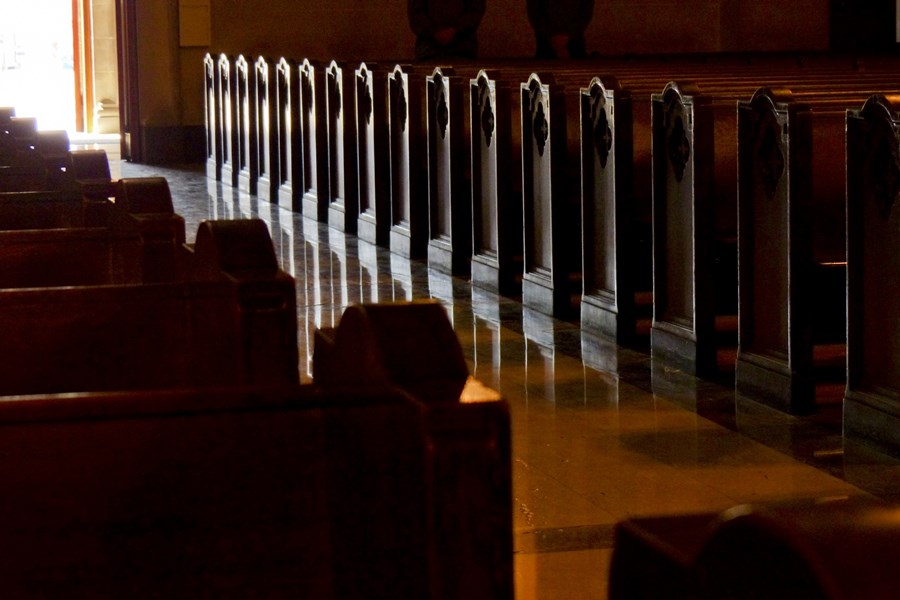REOPENING OUR CHURCHES: HOW DO WE BEGIN?

Within the months that coronavirus has swept across the globe, communities have been injured, spirits strained, countless have lost loved ones, and countless others have been risking their lives daily to ensure the safety and care of the rest of us. Thankfully, communities have rallied together to thrive in their care for one another, exemplifying the compassion the Lord guides us with during these trying times. And as a beacon of light, our faith leaders have continued to offer pastoral care through live-streaming weekly masses and remaining virtually connected with their members.
There is no one right way to begin reopening our society, but there is a wrong way. We must remain informed and patient, taking this process one step at a time to ensure that every possible precaution is taken along the way.
During times of crisis we look to our leaders to guide us and set good examples for how to cope and proceed. We must remember that although we are separated, we are still united, as one CHURCH TOGETHER. While business may not run ‘as usual’ we can look hopefully toward a brighter and healthier future.
While we begin to inform ourselves on what re-opening our churches will entail, please note that in accordance with state and federal guidelines, we must remain sheltered in place and continue to worship online until such a time that it is declared safe to gather.
In the meantime, Governor Cuomo has begun releasing plans for how we will reopen New York in phases:
- Phase One: “Low risk” businesses, such as construction and manufacturing
- Phase Two: Opening industry based on priority risk factors. More essential businesses with inherent low risks of infection in the workplace (and to consumers) will be prioritized, followed by other businesses considered "less essential" or those that present a higher risk of spreading infection.
Each phase will be followed by a two-week period to monitor the effects of reopening and ensure hospitalization and rate of infection are not increasing. Regional attractions/business that may draw large crowds, especially from outside the area, will continue to be postponed until the pandemic has been stabilized. The governor has stated that these procedures will take multi-state coordination, especially downstate New York, with the reopening of transportation, schools, parks, and beaches. For further information from the governor’s office click HERE.
Once we have begun to reopen, it is important to remember that we cannot go back to our pre-coronavirus conduct instantly.
It is recommended by the CDC that we continue to mitigate our physical contact until the pandemic has been contained.
We must continue to:
- Keep our distance from one another
- Avoid hugs and handshakes
- Keep our faces covered both in work and worship
Click HERE to read the CDC’s “Interim Guidance for Administrators and Leaders of Community- and Faith-Based Organizations to Plan, Prepare, and Respond to Coronavirus Disease 2019 (COVID-19)”.

As children of God our priority should be protecting the safety of each other, especially our most vulnerable siblings: young children under 3, the elderly and those with weak immunity, or pregnant and nursing parents. If you plan on reopening, it is recommended NOT to begin your reopening with a Worship Service, but rather begin with a smaller gathering, such as Bible Study, in order to do a test-run of these safe practices with smaller groups of people.
Proper precautionary measures to be taken:
- Keep well-stocked on soap, paper products & hand sanitizer
- Place no-touch trash cans around your church
- Make sure hand sanitizer of at least 60% alcohol is available to churchgoers
- Publicize individual precautions to take and symptoms of COVID-19 in posters, handouts and digital material.
- Face masks should be made a requirement and the church should be prepared to provide them and/or to deny entry to those who refuse to comply.
- Delineating seating by using tape on the pews to ensure the greatest distance between those in them, outside of shared households; utilizing ushers to assist with this would be beneficial as well.
- Implement the recommended precautions to clean your church. Keep it as an implied understanding that they have been completed and that members are still entering at their own risk.
- Prayer books and printed handouts should be put away for now, minimizing the items which require disinfecting and risk increasing the rate of infection.
- Ask members if they’ve tested positive for the virus before entering or have them take their temperatures before leaving home.
- If members of your congregation have experienced or been exposed to COVID-19 it is best if in-person worship be postponed to avoid the risk of spreading the virus to other members.
- If a person(s) exposed to the virus has been in building, keep the building closed and follow proper cleaning procedures to disinfect the area; a more detailed article on cleaning your church to follow soon.
- For the time being, it is still recommended to avoid communion so as to continue to limit contact with each other.
- It is recommended not to offer communion wine, for according to our Lutheran understanding, if you prefer to receive only the bread, you still receive the full benefit of the sacrament.
- Refrain from including singing in worship for the time being. If music must be performed during service, it is advisable that it consist of no more than a solo instrumental or a prerecording of which any singing must be kept silently to ourselves. Epidemiologists and virologists believe singers could absorb many more airborne particles, as they tend to breathe deeper into their diaphragms than they would during normal breathing. So, while the space between us may be safe, and our faces covered, we still share the same enclosed air which heightens our risk even more. Read more on this, HERE.
For a more detailed description of these guidelines and recommendations from the CDC, click HERE.
While we are still figuring out how to return to opening up our churches again, we may still need to rely on technology to broadcast our services and keep our members connected.
Alternatives to in-person meetings:
- Small group sessions like Bible Study should remain online for now, but may act as a good starting point to test how regathering may work.
- Continuing to offer online live-stream services, even if in-person worship is reinstated, is a safe way to limit the number of people in the building, in addition to catering toward members who may still be sick or unable to leave homes.
- Consider bringing worship outside to allow more space for social-distance and better airflow. Members could also stay in their vehicles, safely separated yet connected and still able to listen to the word.
- Mission support is also recommended to remain online, again taking all precautions to avoid touching shared surfaces.
For a more detailed description of these guidelines and recommendations from the CDC, click HERE.
It is imperative that churches and church leaders continue to practice good sense when considering the reopening of religious buildings and public worship.
We must consider that guidelines are different for employees and the worshipping public.
- Under OSHA and other employee protection rules “employees with religious functions” are not protected by OSHA.
- Conversely “secular employees” (i.e. maintenance, cleaning, purely clerical, etc.) are protected under OSHA and the same applies for churches’ schools, where the employer is obligated to provide a safe working environment for staff. This in understood to include flexibility with working from home, and sick-leave. In the State of New York, it has been interpreted to include protection from bacteria and virus, thus the security and remediation may be required in relation to employees (teachers, administrators) and students as well. There is obligation to protect the safety of students than the general public, that is, the congregation.
Read more on OSHA and “Guidance on Preparing Workplaces for COVID-19,” HERE.